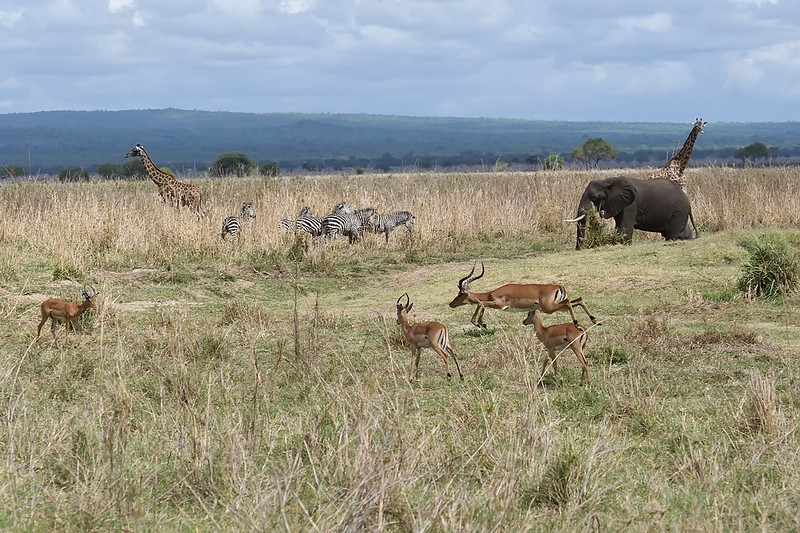Seronera Region
The Seronera region is situated within the Serengeti National Park, located in northern Tanzania. It is located in the center region of Serengeti National Park, a renowned destination for tourists, featuring a diverse array of wildlife species and several predators, including large felines like as lions, leopards, and cheetahs. Serengeti National Park, a UNESCO World Heritage Site, is the oldest national park in Tanzania, encompassing around 14,750 square kilometers and serving as a prominent tourist attraction.
The Seronera Valley is distinguished by savannah plains, woodlands, and acacia trees. The savannah plains of Serengeti National Park are characterized as boundless expanses interspersed with scattered trees. Additional wildlife species observable in the Seronera region encompass elephants, hippos, buffalo, impalas, topi, gazelles, zebras, wildebeests, and rhinos, among others.
The Seronera area is accessible year-round, and tourists wishing to observe the great wildebeest migration should visit the national park between April and June to witness around 2 million wildebeests grazing in the open savannah. The Seronera river, located in the Seronera region of Serengeti National Park, serves as a vital water source for several wildlife species, including wildebeests, zebras, gazelles, antelopes, and elephants.

The Seronera airport facilitates visitor access to the core region of Serengeti National Park by air travel. Flight options to the Seronera region comprise regular flights and charter flights. Approximately five airlines operate flights to the Seronera region, facilitating visitor access to the national park. These include Coastal Aviation, Air Excel, and Auric Air.
Additional airstrips inside Serengeti National Park comprise Kogatende airfield, Serengeti Kusini airstrip, Fort Ikoma airstrip, and Kirawira airstrip, each situated in distinct regions of the park. An alternative route to the Seronera area in Serengeti National Park is to drive from Arusha, which takes approximately 7 to 8 hours. During your trip to the resort, you can see the diverse fauna and the stunning wide plains within the national park.
Activities conducted in the Seronera area encompass the following:
Safari excursions
Game drives are the predominant wildlife observation activity conducted during visits to the Seronera region, renowned for its population of large felines, including lions, leopards, and cheetahs. While traversing the expansive savannah plains of Serengeti National Park, you will observe a variety of wildlife species, including wildebeests, zebras, antelopes, giraffes, elephants, buffalos, waterbucks, elands, hyenas, and several avian species. Game drives occur at various times throughout the day, including morning, afternoon, or evening, and may also be conducted for an entire day. In the morning game drives, wildlife species exhibit heightened activity, facilitating their visibility in the Seronera region.
Game drives in the Seronera region
Observing the large felines in their natural habitat is a prominent feature of safaris in the Seronera region, where predators like lions, leopards, and cheetahs pursue their prey across the expansive grassland of Serengeti National Park. While on game drives in the Seronera region, visitors to Serengeti National Park can observe many wildlife species grazing and hunting on the savannah plains, as well as appreciate the park’s stunning landscapes.
During these game excursions, travelers are urged to remain on designated paths while observing the various wildlife species in the Seronera region. Another guideline to adhere to during game drives in the Seronera region is to minimize noise, as it frightens wildlife and disrupts their natural habitat. Provision of sustenance to wildlife species during game drives in the Seronera region is likewise forbidden. Feeding wildlife species disrupts their natural feeding behaviors.
Bird Watching
Birdwatching is an activity conducted on a safari in the Seronera region of Serengeti National Park. This activity can be conducted year-round in the national park. The optimal period for avian observation is from November to April. This activity is also favored by tourists visiting the Seronera region of Serengeti National Park.
Serengeti National Park hosts over 500 avian species, encompassing both indigenous and migratory birds. The avian species of Serengeti National Park encompass hornbills, woodpeckers, grey-chested helmet shrikes, starlings, eagles, yellow-throated sandgrouse, vultures, weavers, among several others. Notable attractions to observe during a safari in the Seronera region include the following:
Kopjes
Kopjes encompass the Simba kopjes, where lions are observable during a safari. Kopjes are prominent rock outcrops that distinguish themselves from the surrounding landscape in Serengeti National area and are notable attractions during exploration of the area.
Seronera Valley
The Seronera Valley is renowned for its abundant big cat population, rendering it a favored destination for travelers on safari in Serengeti National Park. Additional predators observable on a safari encompass hyenas, serval cats, caracals, and jackals, among others.
Large felines
Large felines, including lions, leopards, and cheetahs, are among the wildlife species observable in the Seronera region during a national park safari. Observing these predators during their hunt is one of the anticipated pleasures of a safari. Lions are also observable around the kopjes, including the Simba kopjes in the Seronera region.
Migration of wildebeest
The great wildebeest migration is a yearly phenomenon occurring in Serengeti National Park and Masai Mara National Reserve, where nearly 2 million wildebeest traverse the Mara-Serengeti ecosystem in pursuit of more fertile grazing grounds. During the migration occurring between April and June in the Seronera region, predators like lions, leopards, cheetahs, and hyenas are observed trailing the wildebeests, poised to seize opportunities for predation. Additional wildlife species, including zebras and gazelles, are observable during the wildebeest migration.
Maasai People
The Maasai constitute a segment of the local villages adjacent to the national park. They are recognized for their distinctive culture and nomadic lifestyle. The Maasai people possess local arts and crafts, including beaded necklaces, earrings, sandals, shukas, and belts, among others. Tourists can engage with the Maasai throughout their cultural adventures while on safari.
